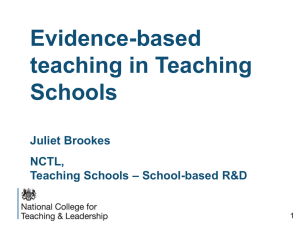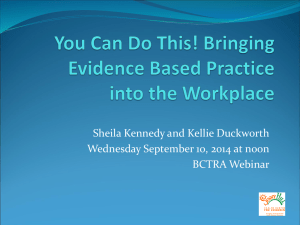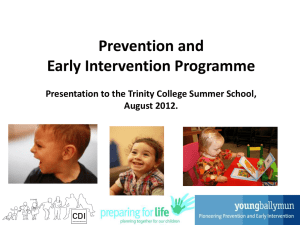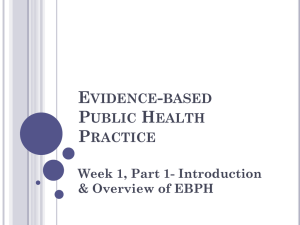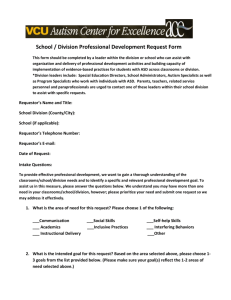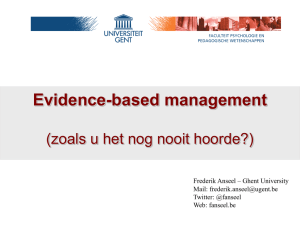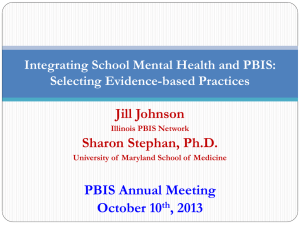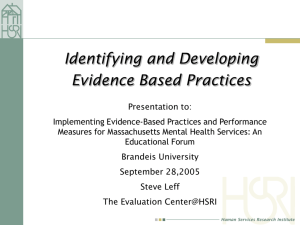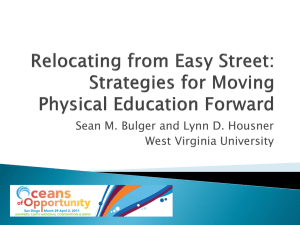Evidence-Based Practices in Psychiatric Rehabilitation
advertisement
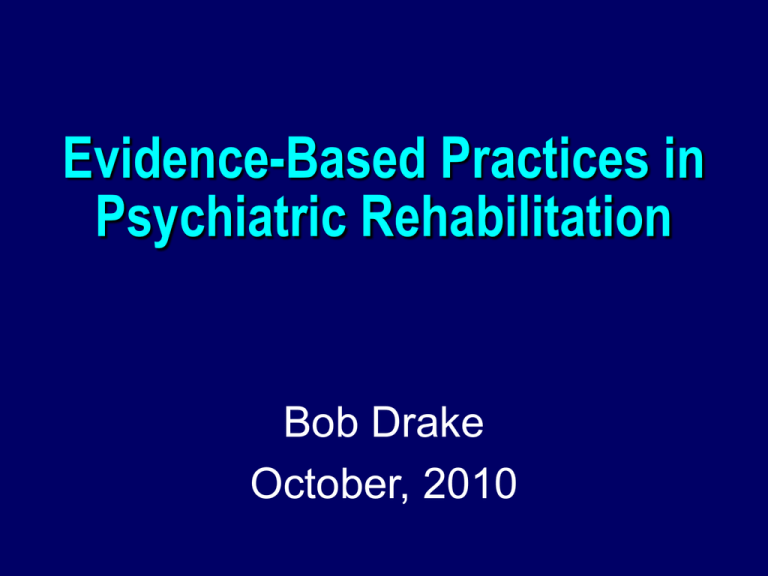
Evidence-Based Practices in Psychiatric Rehabilitation Bob Drake October, 2010 Financial Support to PRC Grants from NIDA, NIDRR, NIMH, RWJF, SAMHSA Contracts from Guilford Press, Hazelden Press, MacArthur Foundation, Oxford Press, New York Office of Mental Health, Research Foundation for Mental Health Gifts from Johnson & Johnson Corporate Contributions, Segal Foundation, Thomson Foundation, Vail Foundation, West Foundation OVERVIEW Definition Update on evidence-based practices Common themes Dissemination and implementation History of Mental Health in U.S. Cottage industry Little attention to outcomes Ineffective and harmful interventions persist for years Effective interventions rarely used Evidence-based Medicine The combination of science, client values/preference, and clinical expertise In mental health care, this means combining science and recovery ideology Evidence-Based Practices Standardized interventions Controlled research More than 1 research group Objective outcome measures Meaningful outcomes Evidence-Based Rehabilitation Practices Robert Wood Johnson Foundation 1998 Assertive Community Treatment Supported Employment Family Psychoeducation Illness Management and Recovery Integrated Treatment for Co- occurring Disorders Assertive Community Treatment (ACT) Community-based team Low caseload Multidisciplinary Outreach Direct service provision 24 hours/7days Number of Studies Research on ACT (cont.) 18 16 14 12 10 8 6 4 2 0 25 Randomized Controlled Trials ACT better than standard treatment ACT not better than standard treatment Time in Hospital Housing Stability Quality Client Symptoms Social Vocational Jail/ of Life Satisfaction Functioning Arrests Mueser KT, et al. Schizophr Bull. 1998;24(1):37-74. Days Homeless on Streets: ACT vs Usual Community Services 250 ACT Usual community services N=152 Days Homeless 200 150 100 50 0 First Quarter Lehman AF. Unpublished data. Second Quarter Third Quarter Fourth Quarter Current ACT Issues 1. Hospital system changes 2. Quality of usual services 3. Forensic ACT 4. Other expansions and components 5. Transitions Supported Employment Focus on competitive work Rapid job search De-emphasis on prevocational training and assessment Attention to client preferences Follow-along supports as needed Supported Employment RCTs 90% 80% 70% 60% 50% 40% 30% 20% 10% 0% 96 94 04 04 04 06 05 99 95 06 00 05 97 02 NH NY CA IL CT SC HK DC IN EUR NY QUE CA MD (IP S) (SE) (IP S) (IP S) (IP S) (IP S) (IP S) (IP S) (SE) (IP S) (SE) (IP S) (SE) (IP S) Individual Placement and Support (IPS) vs Enhanced Vocational Rehabilitation (EVR) in Maintaining Competitive Jobs % Working in Competitive Jobs 40 IPS (n=74) EVR (n=76) 35 30 25 20 15 10 5 0 1 2 3 4 5 6 7 8 9 10 11 12 13 14 15 16 17 18 Study Months Drake RE, et al. Arch Gen Psychiatry. 1999;56(7):627-633. Current SE Issues 1. Financing 2. Cognitive strategies 3. Effective specialists 4. Disability reform Family Psychoeducation Provided by professionals Long-term (over 6 months) Single and multiple family group formats Focus on education, stress reduction, coping, and other support Oriented toward future, not past Effects of Family Intervention on 2-Year Relapse Rates (12 Studies) % Cumulative Relapse Rate 100 75 50 25 0 Standard Care (n=203) Single Family Treatment (n=231) Multiple Family Single and Multiple Group Treatment Family Group (n=266) Treatment (n=243) Mueser KT, Glynn SM. Behavioral Family Therapy for Psychiatric Disorders; 1999. Montero I, et al. Schizophr Bull. 2001;27(4):661-670. Current FPE Issues 1. Effectiveness failure 2. Family-to-family and alternatives Illness Management Training Helping people learn to manage their own illnesses Relapse prevention Minimize the effects of residual symptoms Research on Illness Management Components Psychoeducation increases knowledge and awareness Behavioral tailoring increases effective use of medications Warning sign recognition reduces relapses Cognitive-behavioral treatment reduces residual symptoms Effect Size on Social Adjustment Social Adjustment* Outcomes: Cumulative Effect Sizes 0.9 0.8 0.7 0.6 0.5 0.4 0.3 0.2 0.1 0 Personal therapy (n=74) No personal therapy (n=77) p=.004 Intake Year 1 Year 2 Years in Treatment Year 3 *Social adjustment=work performance, relations in the home and with external family, social leisure, general adjustment, interpersonal anguish, social relations, role performance, normal functioning, Brief Psychiatric Rating Scale (BPRS) score, and Global Assessment Scale (GAS) score. Hogarty GE, et al. Am J Psychiatry. 1997;154(11):1514-1524. Current IMR Issues 1. More research 2. Training 3. Hard outcomes 4. Simplification Integrated Dual Disorders Treatment Mental health and substance abuse treatments combined by 1 team • Assertive • Stage-wise • Individualized • Comprehensive • Long-term % of Patients in Stable Remission ACT and Integrated Dual Disorders Treatment 60 50 High-fidelity ACT programs (n=61) Low-fidelity ACT programs (n=26) 40 30 20 10 0 Baseline 6 12 18 24 Assessment Point McHugo GJ, et al. Psychiatr Serv. 1999;50(6):818-824. 30 36 Current IDDT Issues 1. Standardization 2. Group and residential interventions 3. Supported employment 4. Staging 5. Simplification Common Features of Evidence-Based Rehabilitation Practices Shared decision making and choice Individualization Skills and supports in the community Adult roles Quality of life Additional Rehabilitation Practices Social skills training Supported housing Supported education Integrated medical care Trauma interventions Dissemination and Implementation Science to service gap No simple solution for complex systems Multiple strategies Phases of implementation All stakeholders Fidelity National EBP Project Phase I: conduct reviews, prepare implementation packages (toolkits), and establish state technical assistance centers Phase II: field tests to refine procedures and resource materials Phase III: national demonstration Conceptual Framework for Implementing an Evidence-Based Practice Families Consumers Implementation Package Mental Health Authority Strategies and Barriers EvidenceBased Practice Client Outcomes Administration Program Leader Other Factors Practitioners Com m unity Me ntal He alth Ce nte r Intervention Stakeholders Implementation Process Implementation Outcome System Changes 1 Evidence-based medicine Address 3 components: science, consumer involvement, practitioner skills Align financing and structures with goals Integrate treatment and rehabilitation: mental health, substance abuse, vocational rehabilitation, general health, housing, selfhelp, family supports System Changes 2 Improve data systems to focus on outcomes and fidelity Enhance self-management Electronic records and decision supports: education, assessment, outcomes, decision making Engineer micro-systems of care Learning collaboratives Distance learning Current Concerns Fidelity and outcomes Access and acceptability Durability Multi-cultural services Flexibility Financing Organization Conclusions Evidence-based rehabilitation interventions are available and will improve rapidly Implementation requires changes in organization and financing Flexible, individualized application requires flexible clinicians and organizations Further Information Patti O’Brien Patti.O’Brien@Dartmouth.edu 603-448-0263 www.mentalhealth.samhsa.gov
